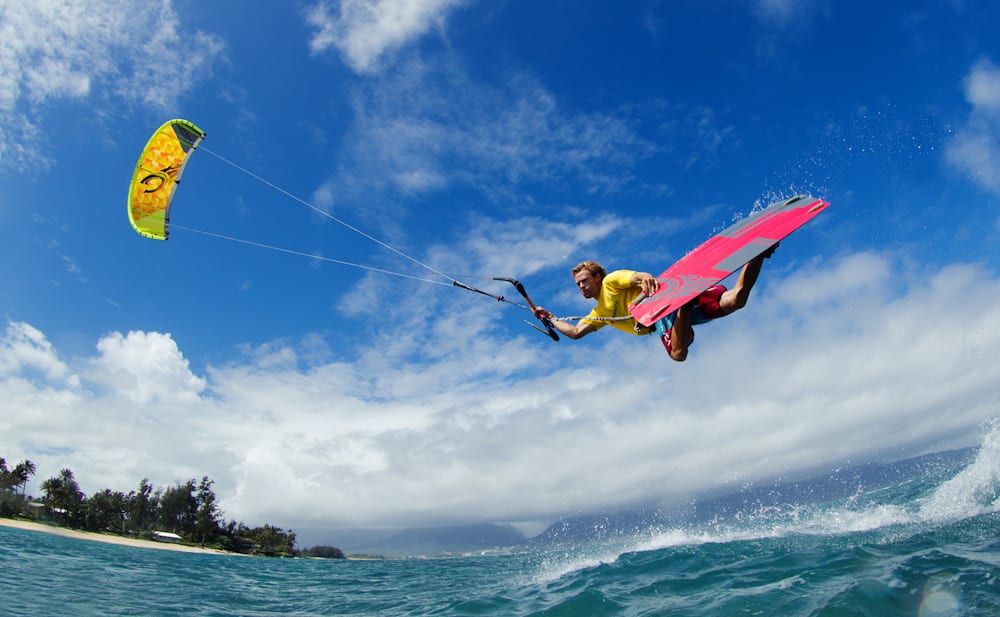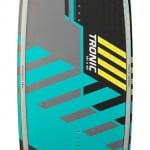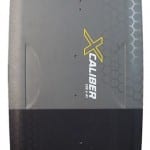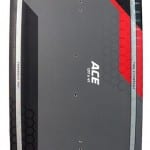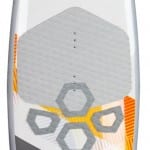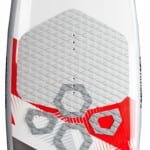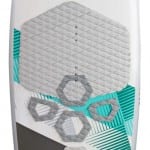Visit CABRINHA for more info.
Get full 2015 gear info from 26 brands in the TKB 2015 Buyers Guide.
Cabrinha is introducing several new products to their 2015 lineup including the Radar and Genesis kites as well as the new Ace twin tip. They also streamlined their directional boards to three models including new signature boards from team riders Reo Stevens and Keahi de Aboitz, and are particularly excited about the new SMARTLOOP quick release on their control bars. Cabrinha’s Todd Greaux walks us through the big changes and detailed refinements made to Cabrinha’s 2015 product line.
What are the biggest changes for Cabrinha’s 2014 kite line? At Cabrinha, we are always striving to obtain a never ending goal of top performance in an easy to use package. For 2015, we see a lot of refinements throughout the kite range, such as reduced diameter struts and improved handling characteristics in the larger drifter sizes and all of the Switchblades. We launched an all new kite dedicated to the school and progression part of the market, and named it the radar. The Contra’s success led us to add a new size better suited for light riders, and the chaos has been pushed to be even more aggressive for our top pro freestyle athletes. We have refined the Velocity to have better VMG upwind ability and increased its already massive wind range. Lastly, we launched an all new strutless inflatable trainer called the Genesis.
The Radar is an entirely new kite for 2015. How does it fit into the lineup? The radar is our best relaunching kite to date. It’s a full bodied, swept wing, 3-strut kite with reliable park and ride power. Any input given to the control system translates into an immediate response from the kite. It is a perfect kite for a person getting into the sport as it will keep up with you as you progress in freestyle or freeride and has credible skills in the surf arena.
The Switchblade has been a very popular kite for the past couple years. What changes have you made for 2015? The Switchblade is our most evolved and highest volume selling kite model. The first Switchblade was the second generation bow kite. With really fast depower and improved turning speed, added to its huge wind range, it was the perfect introduction of the bow kite for the freestyle riders on the team. Over the years, the shape of the kite evolved with many refinements including the departure from a pure bow kite to a hybrid kite with medium sweep. Now in its 10th edition, designer Pat Goodman is convinced that this is the best version to date.
In the Switchblade 2015 the kite keeps its DNA of park and ride stability, huge wind range, direct steering and great relaunch, but you will be most impressed with the improved low end power. The profiles of the kite have been enhanced to optimize its performance in all conditions. there has also been quite some work done in the bridling of the kite, so it is much more stable and less sensitive to back stall in light wind conditions.
The Contra and Velocity are both very capable light wind weapons. How should a rider choose between the two as a low wind option? The Contra is really about having fun in light winds, and is fully dedicated as a light wind kite. The Velocity is designed as a full wind range kite with performance as the single goal. So if pure power per size, full wind range, and upwind performance are the most important features, then the Velocity is superior. However, the Contra has a broader application in the market as it has very light bar pressure, turns fast for its size, unhooks well, relaunches easily, and excels as a fun to use product in light wind conditions. Lastly, the Contra has extra “grunt,” and therefore can use a wider range of boards in the light winds while the Velocity uses more apparent wind to generate it’s horsepower and usually benefits from a more advanced kiter at the controls.
You introduced the concept of on-the-fly adjustable bar ends last year. What changes have you made to the bar for 2015? In 2015 we have quite a few new features and options on the control systems. The single biggest change has been made to the quick release system and its loop. The Quickloop is a quick and easy QR system. You may have seen similar systems but what makes the Quickloop exclusive is that it’s the fastest to reset on the market from what we’ve tested. It is so simple and easy to use that it can be operated with a single hand. The Overdrive1X can be adjusted while riding, and you can use it on your entire kite quiver.
The bar width has a major role in the turning speed of the kite, so you can customize your turning speed quick by switching the position of the bar ends depending on what you want. We didn’t make any changes to the design of this function on the bar in 2015. The Overdrive1X comes in two different sizes, both of them adjusting 8cm. The STD version can adjust from 48 to 56cm and the XL version from 57 to 65cm. The brand recommends the STD version for any size from 4m to 14m, with optimum performance with 8m to 12m kites. For the light wind above 14m we recommend using the XL bar. In addition, we offer the Fixed CS bar, available in two sizes: 45cm for the small one and 55cm for the bigger one. This fixed bar is ideal for those looking to save some money without compromising performance. The small size is also particularly suited for the typical fast sizes, 7m and smaller.
The Drifter is back for 2015 as your dedicated wave kite. What changes or overall design elements make this kite suited to perform in the surf? It was hard to make this kite better. The main focus was on small tweaks in the large sizes to lower bar pressure and increase turning speed.
What construction techniques are featured in the 2015 twin tip line? In general, most of our twin tips are produced using basalt fiber construction which has strength properties much higher than fiberglass and better dampening properties for a smooth ride. Naturally minded and produced in a pure process, the technique is absent of toxic additives. Our high performance boards are built with a high Reflex Carbon Fibre Laminate – a lightweight and durable carbon fiber laminate that stiffens the flex pattern for increased response and explosive pop. Additionally, select carbon reinforcement provides the highest strength-to-weight ratio available on the market. All boards come with our unique GFN Hex flow fins which feature a hexagon dimpled pattern over the surface of the fin. The hex pattern helps to create a boundary layer which assists in the laminar flow over the fin.
- Tronic
- X-Caliber
- Ace
How would a free rider choose between the Tronic and Spectrum line of boards? The Tronic is for riders who like to get huge air and carve turns in the surf whereas the Spectrum is for the rider who wants a versatile performance twin tip that likes to cruise.
The X Caliber, Custom, CBL and the new Ace are all performance freestyle boards, but what kind of riding style or target audience is each model specifically designed for? The X Caliber is a premium competition freestyle board designed for the high end competitor. The extensive use of carbon allows this board to be our lightest, most technical twin tip in the range.
The Ace is for freestyle riders who ride in any type of wind and water condition and experiment with alternate riding categories. It’s fast, smooth, and responsive. It’s built with a Parabolic Rail TM and basalt laminate construction. The Parabolic Rail provides a stiffer center section while delivering a more responsive tip and tail flex, keeping the board weight to a minimum.
The Custom is for progressive wakestyle riders that want a smooth ride. It’s also built with our Parabolic Rail TM and basalt laminate construction and has a medium rocker line to maintain upwind performance.
The CBL is for riders who like wakestyle and cable riding, or like to mix it up between the park and kite. The P-Tex base is perfect when hitting obstacles. The rail channels provide the bite and the flat top 20mm GFN hex flow fins keep things grippy when needed and don’t need to be removed at the park for added convenience.
Any changes in the footstrap/binding line for 2015? The H2 binding has been redesigned to have a completely floating upper section that caps off the five way adjustable system. The new floating upper allows a more custom fit for the top of the rider’s foot. The premium H1 has also been redesigned to have the same comfort and adjustability as before but at a lower cost. The H3 is our all-new full boot. The H3 is specifically designed for kiters with easy velcro entry and exit, an ultra-lightweight outer shell, and a lower profile upper section designed for more lateral movement without sacrificing support. Other features include neoprene flex zones for flexibility, a closed toe design to reduce cramping and improve fit, and a lightweight nylon baseless chassis to give you a solid board feel with maximum impact absorption.
For 2015 the surfboard lineup has narrowed to three shapes. What type of surfing are these boards designed for? The most important changes to our directional line have been made in width, volume, and construction. Wider widths and higher volumes have been implemented in the area most needed. Each board in the range is different from the other which presents a completely different surfing or freestyle experience with each model.
The Proto is made for the surfer who needs a board that will excel in side shore and down the line surf. Next, we have the Phenom which is ideal for riders who are looking for a high performance surfboard with volume and trick riding capability. Finally, we offer the Secret Weapon for riders who surf in any type of waves and also need a board for flat water freestyle tricks.
- Proto
- Phenom
- Secret Weapon
Specifically, how did the Keahi and Reo model develop and what are the standout differences that riders will experience? Both Keahi and Reo worked with Pete Cabrinha on the outlines as well as the volume and rocker. They made some prototypes in Maui and refined the shapes from there. They are both very powerful riders that ride in all types of conditions. They often ride in larger waves with light wind so they pushed the volumes up to where they are now. This allows them to generate a lot of speed from the wave and not necessarily from the kite.
Since Keahi does competitions he wanted a board with maximum versatility. That’s why the Phenom is offered in a 5-box configuration. It can be ridden as a quad fin or a thruster fin set-up. This makes this board work well in either side shore or onshore conditions.
Reo Stevens often rides down the line waves in side shore conditions. He needed something he could push hard through turns. This is where the Proto shines.


